Paint Shop – 31 : Chicago and North Western Boxcar 4430, part 2 [Works_Boxcars]
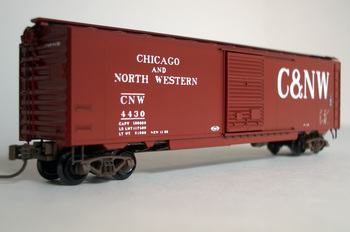 : CNW4430
: CNW4430Here are the data of the car and a belief history of the railroad.
CNW 4142 - 4641 series boxcars:
These cars were built in 1955 by Pullman-Standard.
The CNW series 4142 to 4641 is shown with AAR Designation XM and description “Box, Stl., Wood Lined, Odd & Even Nos.” The inside length of these cars was 50 feet 6 inches, inside width 9 feet 2 inches, inside height 10 feet 5 inches, outside length 54 feet 4 inches, extreme height 15 feet 1 inch, door opening 8 feet, and capacity of 4844 cubic feet or 100,000 pounds. There were 239 cars in April 1974 ORER.
Chicago and North Western Transportation Company (reporting mark CNW) has its roots in the Chicago and North Western Railway chartered in 1859 which succeeded bankrupt Chicago, St. Paul and Fond Lu Lac Railroad established in 1855. The network spread out in 11 Midwest United States.
In 1960, the company acquired Minneapolis and St. Louis Railway.
In 1968, Chicago Great Western Railway was folded into the system.
In 1972, the company became “Employee Owned”
In 1983, former Chicago, Rock Island and Pacific Railroad’s main line from Minneapolis–Saint Paul to Kansas City was folded into the system.
In 1995, the company was merged into Union Pacific Railroad.
The map below is the part of “Union Pacific Map of the United States” printed in 1971 with the CNW route filled in green line, referring to the 1967 Rand McNally Handy Railroad Atlas, by the author.
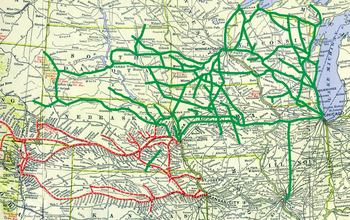 : CNW route map
: CNW route map2014-04-04 09:00
コメント(0)
Paint Shop – 32 : Erie Boxcar 67908, part 1 [Works_Boxcars]
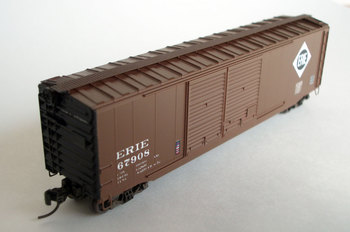 : ERIE67908
: ERIE67908Here is another completed model using CDS product.
This is a model of ERIE 50’ double sliding door boxcar 67908. 67908 is the number afforded by CDS. I came to find the 2008(!) prototype photo of 67908 at the Fallen Flag site. There also are photos of 67904, 67907, 67966 and 67992 in this series at the site.
I used Athearn PS-1 double door boxcar. I stripped the decoration and added a little modification to the sill. Stirrups are replaced with BLMA #402. Brake wheel is replaced with MTL Ajax. Trucks are replaced with Athearn Bettendorfs. I Painted TAMIYA TS-1 together with TS-14 this time. The dry transfer I used is CDS #N-378. Microscale #60-1 decal is also used for the data.
ERIE 67908 photo found at Fallen Flag site;
dry transfer I used;
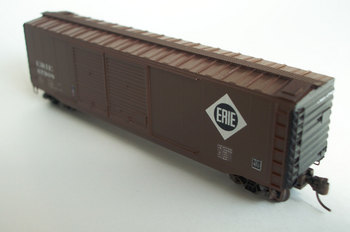 : ERIE67908
: ERIE679082014-06-13 09:00
コメント(0)
Paint Shop – 33 : Erie Boxcar 67908, part 2 [Works_Boxcars]
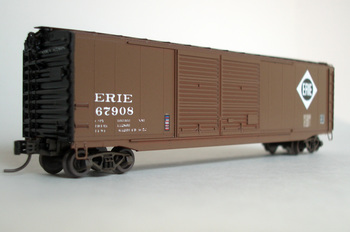 : ERIE67908
: ERIE67908Here are the data of the car and a belief history of the railroad.
ERIE 67900 - 67999 series boxcars:
These cars were built in 1959 by Pullman-Standard.
The ERIE series 67900 to 67999 is shown with AAR Designation XL and description “Box, Stl., 12 Belt DF Loaders, Wood Flr. Covered with 1/8” Perforated Stl. Flr., Stagg. Doors”. The inside length of these cars was 50 feet 6 inches, inside width 9 feet 2 inches, inside height 10 feet 5 inches, outside length 54 feet 4 inches, extreme height 15 feet, door opening 15 feet, and capacity 4822 cubic feet or 100,000 pounds. There were 22 cars in the April 1974 ORER.
Erie Railroad (reporting mark ERIE) connected Chicago, Cincinnati and New York along by the Lake Erie. The railroad has its roots in the New York & Lake Erie Railroad chartered by the governor of New York in 1832. The route from New York to the Lake Erie was completed in 1851. In 1859, the railroad was reorganized as Erie Railway, and again in 1895 as Erie Railroad.
In 1960, Erie Railroad and its long-time competitor Delaware, Lackawanna & Western Railroad merged to create Erie Lackawanna Railroad. Unfortunately, however, EL went bankrupt in 1972 and Consolidated Railroad Corporation (Conrail) assumed its operations in 1976.
The map below is the part of “Union Pacific Map of the United States” printed in 1971, with the ERIE route filled in red line by the author.
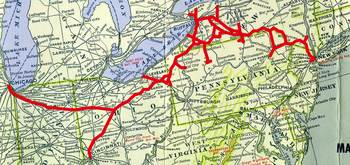 : ERIE route map
: ERIE route map2014-06-20 09:00
コメント(0)
Paint Shop – 34 : New Jersey, Indiana and Illinois Boxcar 3495, part 1 [Works_Boxcars]
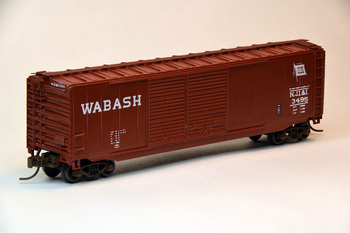 : NJII3495
: NJII3495Here is another completed model using CDS product.
This is a model of NJI&I 50’ boxcar 3495 with small “WABASH” flag logo mark. I came to find the 1983 prototype photo at the Fallen Flag site. RR Picture Archives site also has a picture of 3442 and 3414.
I used Athearn PS-1 double door boxcar. I stripped the decoration and changed the ends with homemade parts: urethane resin casted MTL 51’ 3¾” Mechanical Reefer ends to represent 3/4 pressed improved Dreadnaught ends. To avoid the resin parts warping, I mounted a styrene plate from back.
Painting with TAMIYA TS-33 for the body is the routine. I used CDS #N-642 for the letterings and numbers. Flag logo and large "WABASH" herald came from Jerry Glow Custom Decal for Wabash DD Boxcar because of its crispness.
* Glow closed his business in 2014.
NJI&I 3495 photo at Fallen Flag site;
NJI&I 3442 photo at RR Picture Archives site;
dry transfer I used;
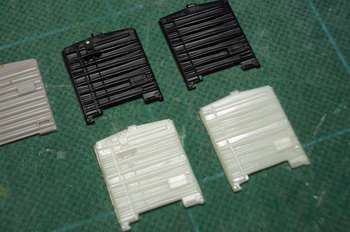 : urethane resin casted MTL ends
: urethane resin casted MTL ends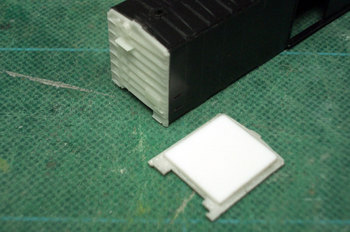 : styrene plate mounted on resin end
: styrene plate mounted on resin end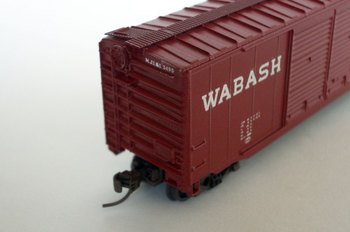 : applied resin casted end
: applied resin casted end2014-08-08 09:00
コメント(0)
Paint Shop - 35 : New Jersey, Indiana and Illinois Boxcar 3495, part 2 [Works_Boxcars]
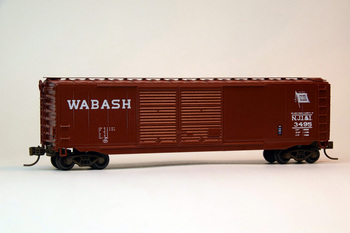 : NJII3495
: NJII3495Here are the data of the car and a belief history of the railroad.
NJI&I 3400 - 3499 series boxcars:
The NJI&I series 3400 to 3499 is shown with AAR Designation XM and description “Box” only. The inside length of these cars was 50 feet 6 inches, inside width 9 feet 4 inches, inside height 10 feet 5 inches, outside length 54 feet 4 inches, extreme height 15 feet, door opening 15 feet, and capacity 4844 cubic feet or 110,000 pounds. 94 cars are listed in the April 1974 ORER.
New Jersey, Indiana and Illinois Railroad (reporting mark NJII) was an only 11.4 miles railroad despite its exaggerated name.
In 1905, sewing machine manufacturer Singer built the line from South Bend, IN to Pine, IN where it connected with the Wabash Railroad. The name was derived from the states where Singer had its plants. The line also served Studebaker as well as Singer.
In 1926, the line was purchased by Wabash.
In 1964, Norfolk & Western Railway leased the parent Wabash Railroad.
In 1982, Norfolk Southern Railway absorbed NJI&I. The line ceased operations shortly thereafter and was abandoned in the late 1990s.
The company itself survives today as a switching railroad southside of South Bend.
NJI&I related site I referred;
The map below is the part of “Union Pacific Map of the United States” printed in 1971, with the NJII route filled in red line by the author.
revised, Jul. 9, 2020
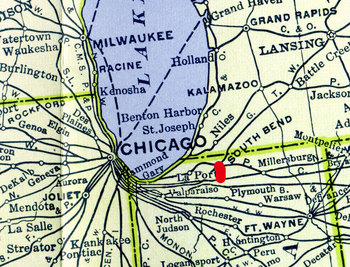 : NJII route map
: NJII route map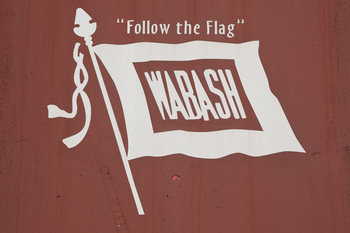 : Orland Park, IL. Sep. 13, 2019.
: Orland Park, IL. Sep. 13, 2019.2014-08-15 09:00
コメント(0)
Paint Shop – 36 : New Jersey, Indiana and Illinois Boxcar 3478, part 1 [Works_Boxcars]
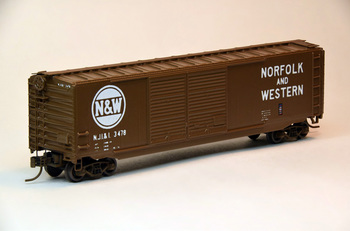 : NJII3478
: NJII3478Here is another NJI&I 50’ 3400 series boxcar, but this time, in N&W “hamburger” scheme. CDS produces this scheme as well as WAB “flag” scheme I represented before.
This is a model of NJI&I 50’ double sliding door boxcar 3478. I came to find the 1984 prototype photo at the Fallen Flag site.
I used Athearn PS-1 double door boxcar. I stripped the decoration and changed the ends with homemade parts: urethane resin casted MTL 51’ 3¾” Mechanical Reefer ends to represent 3/4 pressed improved Dreadnaught ends. Painting with TAMIYA TS-1 (RED BROWN) for the body is the routine. The dry transfer I used is CDS #N-742.
NJI&I 3478 photo found at Fallen Flag site;
dry transfer I used;
2014-08-29 09:00
コメント(0)
Paint Shop – 37 : New Jersey, Indiana and Illinois Boxcar 3478, part 2 [Works_Boxcars]
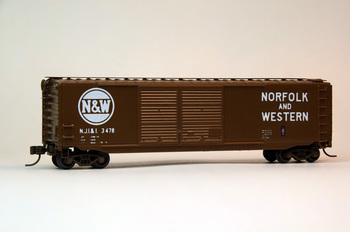 : NJII3478
: NJII3478Here are the data of the car and a belief history of the railroad.
NJI&I 3400 - 3499 series boxcars:
See Paint Shop - 35 : New Jersey, Indiana and Illinois Boxcar 3495, part 2
According to the N&W Color Guide to Freight and Passenger Equipment, the “hamburger” Herald was used between 1964 and 1971. After the NJI&I parent WAB merger with N&W in 1964, these cars were listed in N&W company records (but, individually in the ORER). So, these cars were repainted to this scheme between 1964 and 1971.
New Jersey, Indiana and Illinois Railroad
See Paint Shop - 35 : New Jersey, Indiana and Illinois Boxcar 3495, part 2
I spotted some of the remnants (former headquarter, roundhouse and some of the roadbeds) in Google map below. The roundhouse was demolished in 2018.
revised, Sep. 19. 2019
: NJI&I remnants
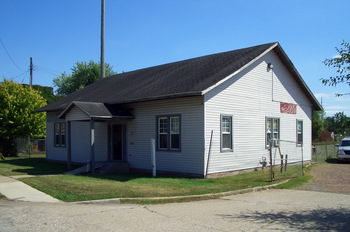 : former NJI&I Headquarter. Sep. 5, 2019
: former NJI&I Headquarter. Sep. 5, 20192014-09-05 09:00
コメント(0)
Paint Shop – 38 : Reading Company Boxcar 115092, part 1 [Works_Boxcars]
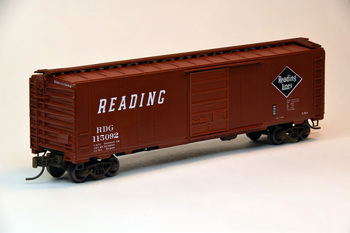 : RDG115092
: RDG115092Microscale produced the decal for RDG freight cars in 2013. This is a boxcar red boxcar realized through using this product.
This is a model of RDG 50’ single sliding door boxcar 115092. I found the 1970 prototype photo of 115052 at Railroad Picture Archives site. Unfortunately, Microscale decal doesn’t have two figure 5s in a sheet. So I chose 115092: that was the easiest displacement using series of numbers offered in the sheet.
I used stock MTL PS-1 Single Door Boxcar for the model. I changed the ends with copied and modified MTL 51’ 3¾” Mechanical Reefer ends to represent 4/4 pressed improved Dreadnaught ends. Doors are changed with MTL Superior doors. Modification is also added to the side panel and sill. Rivets on sides are of Archer product. My regrets are the 7 panel door and high position end tackboard prototype has.
I spray painted the body with Tamiya TS-33 as usual. I polished the surface of the painted body, where decals were going to be applied, with compound. Decal used is Microscale #60-1393. Semi-gloss clear coat is sprayed after decal is applied.
Prototype photo of 115052 found at the Fallen Flag site;
decal I used;
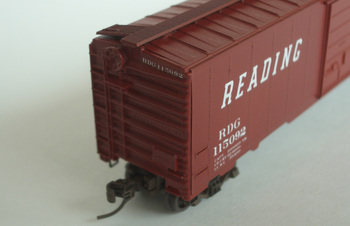 : applied resin casted end
: applied resin casted end2015-01-09 09:00
コメント(0)
Paint Shop – 39 : Reading Company Boxcar 115092, part 2 [Works_Boxcars]
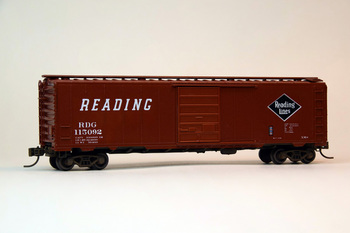 : RDG115092
: RDG115092Here are the data of the car and a belief history of the railroad.
RDG 115000 - 115165 series boxcars:
The WA series 115000 to 115165 is shown with AAR Designation XM and description “Box, Steel. Wood Lining”. The inside length of these cars was 50 feet 6 inches, inside width 9 feet 2 inches, inside height 10 feet 6 inches, outside length 55 feet 3 inches, extreme height 15 feet 1 inch, door opening 8 feet, and capacity 4860 cubic feet or 100,000 pounds. There are 30 cars in the October 1968 ORER, accompanied with 127 cars with 110,000 pounds capacity. The group was shrank to 2 in 1972 ORER and vanished in 1974 ORER.
Reading Company (reporting mark RDG) served southeast Pennsylvania and neighboring states to haul coal efficiently to eastern ports.
Philadelphia and Reading Railroad incorporated in 1833 is the root of RDG. The railroad reached Philadelphia in 1839 and expanded its network till 1893 when it went bankrupt. The holding company, Reading Company was established thereafter to take over the railroad and affiliates.
RDG went bankrupt again in 1971, implicated in the 1970 Penn Central bankruptcy. In 1976, RDG sold its railroad interests to Consolidated Railroad Corporation (Conrail). The line is now part of Norfolk Southern Railway network.
The map below is the part of “Union Pacific Map of the United States” printed in 1971, with the RDG route traced in red line by the author.
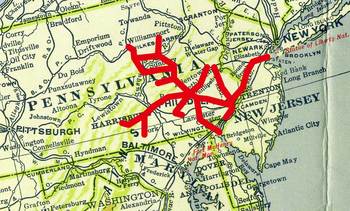 : RDG route map
: RDG route map2015-01-16 09:00
コメント(0)
Paint Shop – 40 : Denver & Rio Grande Western Boxcar 63119, part 1 [Works_Boxcars]
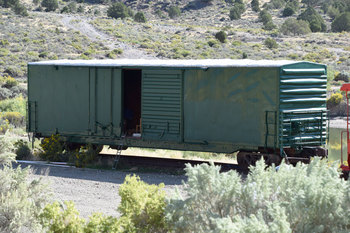 : Sevier County, UT Sep. 15, 2014
: Sevier County, UT Sep. 15, 2014Last year, I found a boxcar repainted and under rebuilding to a cottage at Big Rocky Candy Mountain Resort in Utah. Photos on web and details of the car proved this boxcar as DRGW XM #63119. Accordingly, I tried to restore it to original condition in a model.
1985 photo of #63145 is found in the book Rio Grande Color Guide to Freight and Passenger Equipment. I also found the 1976 prototype photo of #63176 at Railroad Picture Archives site, 1986 photo of #63184 at DRGW. net site. Of course, photos I took at the site helped me modeling it.
I used stock MTL #033 series combination door boxcar for the model. I changed the ends with copied and modified MTL 51’ 3¾” Mechanical Reefer ends to represent 4/4 pressed improved Dreadnaught ends. Roof is changed with diagonal panel roof copied from Athearn NACC boxcar.
8’ sliding door is a copy from Atlas Master PS-1 40’ Boxcar. Ladders are Gold Metal Models product. I lowered the hand brake and added end crossover walkway made from Athearn’s etched-metal roofwalk. I also added thin styrene sheet to represent the gussets besides doors. Stirrup under the short ladder is a BLMA product.
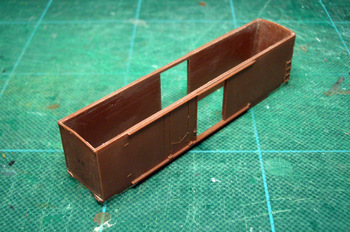 : roof and ends stripped
: roof and ends stripped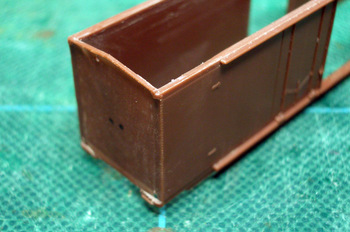 : stripped B end details
: stripped B end details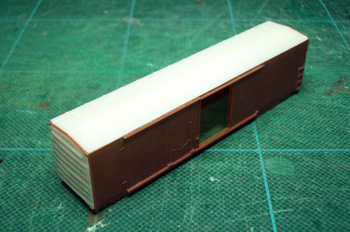 : new roof and ends applied
: new roof and ends applied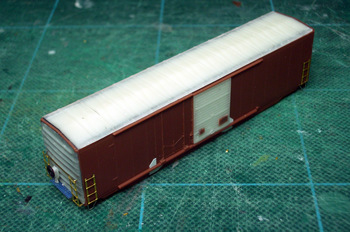 : body ready to paint
: body ready to paintI first painted the body orange with Tamiya TS-12 spray. Next was the silver TS-30 on roof, and finally the black on ends. Decal used is Microscale #60-1213. TS-12 seemed a little more vivid than the orange Rio Grande used. So, I decided to weather it with gloss clear coat and acrylic paints. The results are rather overdone; can’t even see the letterings....
* 2014 photos of DRGW #63119 at my “Photo Archives” web page;
* 1976 photo of DRGW #63176 found at RR Picture Archives site;
* decal I used;
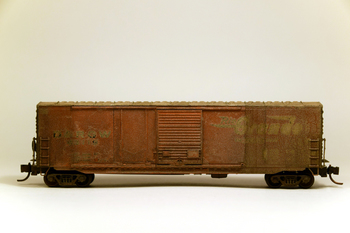 : side view
: side view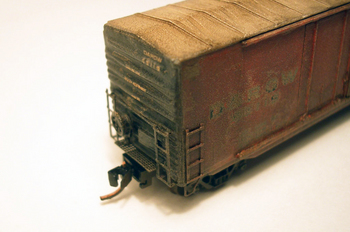 : finished B end details
: finished B end details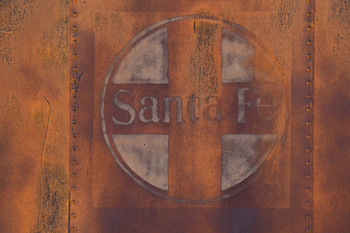 : ghost lettering sample found at Vaughn, NM
: ghost lettering sample found at Vaughn, NM2015-11-20 09:00
コメント(0)
Paint Shop – 41 : Denver & Rio Grande Western Boxcar 63119, part 2 [Works_Boxcars]
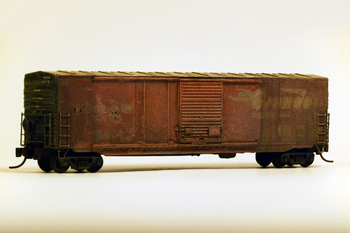 : DRGW 63119
: DRGW 63119Here are the data of the car and a belief history of the railroad.
D&RGW 63100-63199 series Boxcars
The D&RGW series 63100 to 63199 boxcars were built by Evans Products in 1968.
The ORER for July 1974 shows the group with 98 cars in place, described as follows:
AAR Designation XM, Box, Stl. 20” Travel Cush. Under fr., Nailable Stl. Flr., 15’ Double Doors - 8’ Sliding & 7’ Plug-Sliding Doors, Roller Bearings.
The inside length of these cars is 50 feet 6 inches, inside width 9 feet 4 inches, inside height 10 feet 7 inches, outside length 55 feet 2 inches, extreme height 15 feet and capacity 5009 cubic feet or 150,000 pounds.
Denver & Rio Grande Western Railroad (reporting mark DRGW) connected Denver, CO and Salt Lake City, UT thru the Rockies to haul coal and bridge traffic.
The Denver & Rio Grande Railway established in 1870 is the root of the railroad. The railway first extended the route south from Denver to reach El Paso, TX along the Rio Grande; it later changed its destination to Salt Lake City. It reached SLC in 1883 with cooperation with the subsidiary Denver & Rio Grande Western Railway.
The railway went bankruptcy and reorganized as Denver & Rio Grande Western Railroad in 1921. In 1988, the railroad absorbed Southern Pacific Railroad and changed the name to it. The route is part of Union Pacific Railroad network since 1996.
The map below is the part of Union Pacific Map of the United States printed in 1971, with the DRGW standard gauge route traced in orange line by the author.
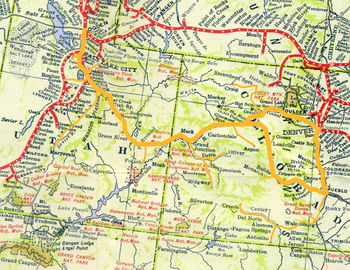 : DRGW standard gauge route map
: DRGW standard gauge route map2015-11-27 09:00
コメント(0)
Paint Shop – 42 : Denver & Rio Grande Western Boxcar 63341, part 1 [Works_Boxcars]
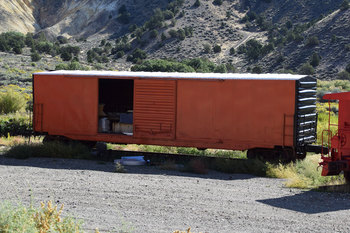 : Sevier County, UT Sep. 15, 2014
: Sevier County, UT Sep. 15, 2014The year before last, I found a boxcar repainted and under rebuilding to a cottage at Big Rocky Candy Mountain Resort in Utah. Photos on web and details of the car proved this boxcar as one of DRGW 63300 to 63499 series XM. Accordingly, I tried to restore it to original condition in a model.
1979 photo of #63404 is found in the book Rio Grande Color Guide to Freight and Passenger Equipment. I also found the 1977 prototype photo of #63341 at Railroad Picture Archives site. As my stock decal set had only a set of digit 4, I decided to model #63341. Of course, the photos I took at the site helped me modeling it.
I used stock Athearn PS-1 Plug Door Boxcar for the model. I changed the ends with copied and modified MTL 51’ 3¾” Mechanical Reefer ends to represent 4/4 pressed improved Dreadnaught ends. The roof is changed with diagonal panel roof copied from Athearn NACC boxcar. Doors are also copied from Athearn PS-1 double Door Boxcar. I added a thin styrene sheet on sides to represent the pressed panels beside doors. Ladders are Gold Metal Models product. Stirrup under the short ladder is a BLMA product. I lowered the hand brake and added end crossover walkway made from Athearn’s etched-metal roofwalk.
I painted the body with Mr. Color Spray #29, a little darker than Tamiya TS-33. I polished the surface of the painted body, where decals were going to be applied, with the compound. Decal used is Microscale #60-82 along with #87-200 for large flying Rio Grande logo, but it’s still a little small. Semi-gloss clear coat is sprayed after decal is applied.
Micro-Trains produced the exact car in Oct. 2021 as MTL-182 00 162.
* 2014 photos of DRGW #63XXX at my “Photo Archives” web page;
* 1977 photo of DRGW #63341 found at RR Picture Archives site;
* decal I used, #60-82 and #87-200;
revised, May 12, 2021
revised, Oct 6, 2021
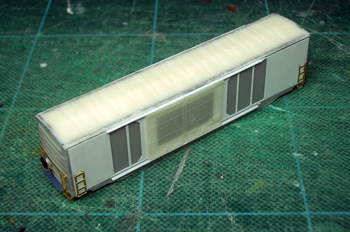 : body ready to paint
: body ready to paint2016-03-04 09:00
コメント(0)
Paint Shop – 43 : Denver & Rio Grande Western Boxcar 63341, part 2 [Works_Boxcars]
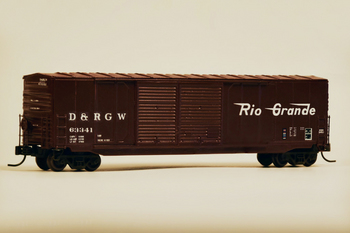 : DRGW 63341
: DRGW 63341Here are the data of the car and a belief history of the railroad.
D&RGW 63300-63499 series Boxcars
The D&RGW series 63300 to 63499 boxcars were built by American Car & Foundry in 1966.
The ORER for July 1974 shows the group with 194 cars in place, described as follows:
AAR Designation XM, Box, Stl. Wood Lined, Cush. Under fr., 50000 lb. Nailable Stl. Flr., Roller Bearings.
The inside length of these cars is 50 feet 6 inches, inside width 9 feet 4 inches, inside height 10 feet 6 inches, outside length 55 feet 2 inches, extreme height 15 feet 1 inch and capacity 4941 cubic feet or 145,000 pounds.
Denver & Rio Grande Western Railroad
See Paint Shop – 41 : Denver & Rio Grande Western Boxcar 63119, part 2
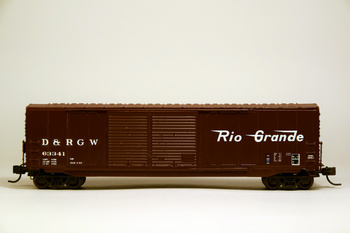 : side view
: side view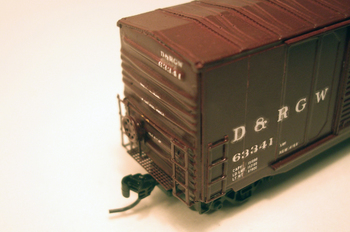 : B end details
: B end details2016-03-11 09:00
コメント(0)
Paint Shop – 44 : Denver & Rio Grande Western Boxcar 63767, part 1 [Works_Boxcars]
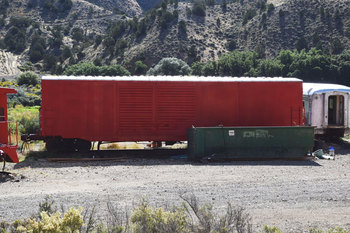 : Sevier County, UT Sep. 15, 2014
: Sevier County, UT Sep. 15, 2014I found a boxcar repainted and under rebuilding to a cottage at Big Rocky Candy Mountain Resort in Utah. As I wrote previously, this boxcar is proved to be DRGW XL #63767[1]. Accordingly, I tried to restore it to original condition in a N scale model.
1964 photo of #63798 is found in the book Rio Grande Color Guide to Freight and Passenger Equipment. I also found the 1981 prototype photo of similar #63704 at Railroad Picture Archives site. Of course, photos I took at the site helped me modeling it.
I used stock Athearn PS-1 Double Door Boxcar for the model. I changed the ends with copied and modified MTL 51’ 3¾” Mechanical Reefer ends to represent 4/4 pressed improved Dreadnaught ends. Roof is changed with diagonal panel roof copied from Athearn NACC boxcar. Brake wheel and roofwalk are MTL parts. Short ladder applied after painting is a copy from InterMountain separate parts. Stirrup under the short ladder is a BLMA product.
I first painted the body with orange Tamiya TS-56 spray. Next was the silver TS-30, and finally the black. I polished the surface of the painted body, where decals were going to be applied, with compound. Decal used is Microscale #60-82. Semi-gloss clear coat is sprayed after decal is applied.
[1] 2014 photos of DRGW #63767 at my Photo Archives web page;
* 1981 photo of DRGW #63704 found at RR Picture Archives site;
* decal I used;
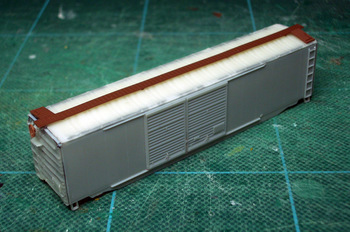 : body ready to paint
: body ready to paint2016-07-15 09:00
コメント(0)
Paint Shop – 45 : Denver & Rio Grande Western Boxcar 63767, part 2 [Works_Boxcars]
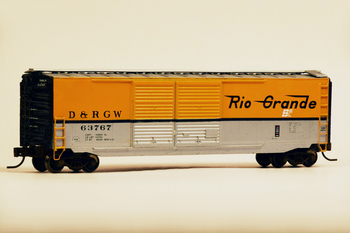 : DRGW 63767
: DRGW 63767Here are the data of the car and a belief history of the railroad.
D&RGW 63712-63799 series Boxcars
The D&RGW series 63700 to 63799 boxcars were built by American Car & Foundry in 1963.
The ORER for July 1974 shows the group with 80 cars in place, described as follows:
AAR Designation XL, Box, Stl. Sparton Easy Loader, (copper Bullion), [Kennecott Copper Co./Garfield/UT & U.S. Smelting & Refining Co./International/UT].
The inside length of these cars is 50 feet 6 inches, inside width 9 feet 4 inches, inside height 10 feet 6 inches, outside length 57 feet 5 inches, extreme height 15 feet 1 inch and capacity 4928 cubic feet or 140,000 pounds.
Denver & Rio Grande Western Railroad
See Paint Shop – 41 : Denver & Rio Grande Western Boxcar 63119, part 2
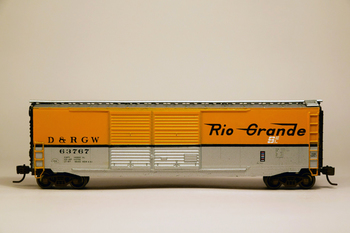 : side view
: side view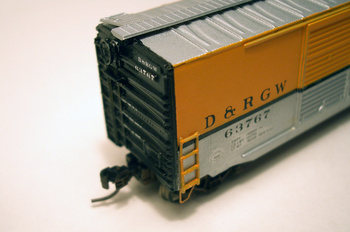 : B end details
: B end details2016-07-22 09:00
コメント(0)
Paint Shop – 46 : Atchison, Topeka & Santa Fe Boxcar 42076, part 1 [Works_Boxcars]
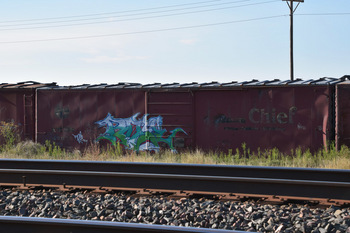
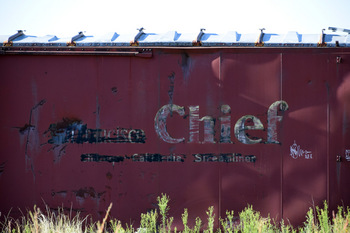 : Encino, NM. Sep. 13, 2015
: Encino, NM. Sep. 13, 2015Last year, I found an ATSF Dharuma-san, a boxcar without tracks, at Encino, New Mexico. Number still remaining on the body proved this boxcar as one of ATSF 42000 to 42749 series Bx-72 class XM. San Francisco Chief slogan was still a charm for me. Accordingly, I tried to restore it to original condition in a model.
1979 photo of #42116 with Ship and Travel slogan from the same class is found in the book ATSF Color Guide to Freight and Passenger Equipment by Morning Sun Books. This MSCG also has photos of #42495 with Texas Chief slogan and #42663 with The Chief slogan from the same class.
I also found the 1979 photo of #42059 with San Francisco Chief slogan at Railroad Picture Archives site.
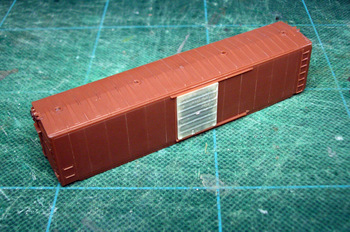 : body ready to paint
: body ready to paintI used stock MTL 031 series 50’ Standard Single Door Boxcar for the model. I changed the doors with Pullman doors copied from Atlas Master PS-1 40’ Boxcar. Side panel joints are corrected based on the prototype. I also cut the side sills referring to the prototype. I changed the assorted MTL roller bearing tracks with surplus Athearn Bettendorf tracks.
I painted the body with Tamiya splay TS-69, a little more brownish than Tamiya TS-33. Ends and roof were painted black. Before applying decals, I polished the surface of the painted body, where decals were going to be applied, with compound.
Decal used is Microscale #60-506. San Francisco Chief slogan is applied on side to the right from the B-end based on Santa Fe Car Slogans list at Santa Fe Railway Historical & Modeling Society web site. Semi-gloss clear coat is sprayed after decal is applied.
* 1979 photo of #42059 at Railroad Picture Archives site;
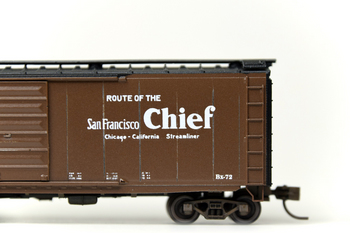 : ATSF 42076
: ATSF 420762016-11-04 09:00
コメント(0)
Paint Shop – 47 : Atchison, Topeka & Santa Fe Boxcar 42076, part 2 [Works_Boxcars]
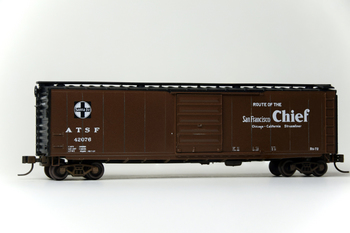 : R-side, ATSF 42076
: R-side, ATSF 42076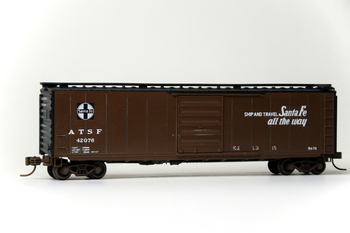 : L-side, ATSF 42076
: L-side, ATSF 42076Here are the data of the car and a belief history of the railroad.
ATSF 42000-42749 series Bx-72 class Boxcars
According to Morning Sun book ATSF Color Guide to Freight and Passenger Equipment, Bx-72 Class XM cars were built by Pullman-Standard in 1957. They were applied slogan stenciling introduced in 1947.
ATSF Car Slogan list suggests #42000 to #42249 in this series were applied San Francisco Chief, #42250 to #42499 were applied Texas Chief and #42500 to #42749 were applied Chief. This #42076 has San Francisco Chief slogan on the right side, contrary to the norm.
The ORER for July 1974 shows the group with 658 cars in place, described as follows:
AAR Designation XM, Box, Nailable Stl. Flrs. The inside length of these cars is 50 feet 6 inches, inside width 9 feet 4 inches, inside height 10 feet 6 inches, outside length 54 feet 4 inches, extreme height 15 feet and capacity 4952 cubic feet or 100,000 pounds.
Train #1 and 2, San Francisco Chief was the lightweight streamlined passenger train connecting Chicago and Richmond via Amarillo, Texas. Connecting bus accomplished the service to Oakland and San Francisco. The train was inaugurated in 1954 and lasted until 1971.
Atchison, Topeka & Santa Fe Railway (reporting mark ATSF) was established in 1859 to connect namesake cities. It reached Los Angeles in 1887 and reached Chicago next year. In 1995, it merged with Burlington Northern Railroad to form Burlington Northern & Santa Fe Railway.
Map below from Sep. 1966 Official Guide shows the ATSF route.
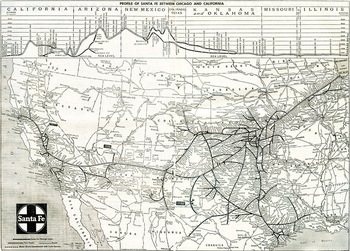 : ATSF route map
: ATSF route map2016-11-11 09:00
コメント(0)
Paint Shop – 48 : Atchison, Topeka & Santa Fe Boxcar 17298, part 1 [Works_Boxcars]
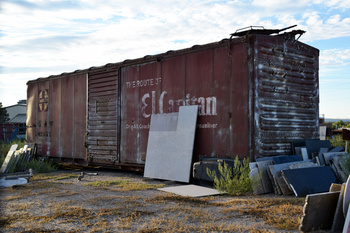
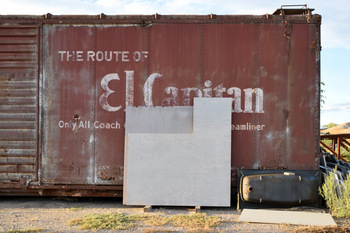 : Albuquerque, NM. Sep. 8, 2015
: Albuquerque, NM. Sep. 8, 2015Last year, I found an ATSF boxcar without tracks but with El Capitan slogan at Albuquerque, New Mexico. Subsequently, to the previous San Francisco Chief boxcar, I tried to restore it to original condition in a model; this time, the prototype is changed to 50’ car to fit my collection.
According to Santa Fe Car Slogans list at Santa Fe Railway Historical & Modeling Society web site, Bx-70 to 75 class cars never carried El Capitan slogan. So, I went back to Bx-69 class XM.
A photo of #17298 with El Capitan slogan is found in the book ATSF Color Guide to Freight and Passenger Equipment. This MSCG also has photo of #17106 with Super Chief slogan from the same class. I also found the 1977 photo of #17259 at Railroad Picture Archives site.
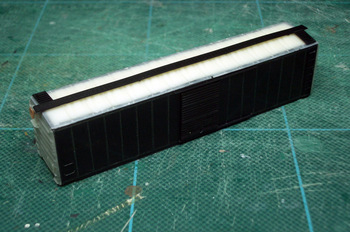 : body ready to paint
: body ready to paintI used stock MTL 031 series 50’ Standard Single Door Boxcar for the model. I changed the ends with copied and modified MTL 51’ 3¾” Mechanical Reefer ends. The roof is changed with diagonal panel roof copied from Athearn NACC boxcar. I also cut the side sills referring to the prototype. Side panel joints are corrected based on the prototype. Rivets are of Archer product. I changed the assorted MTL roller bearing tracks with surplus Athearn Bettendorf tracks.
I painted the body with Tamiya TS-69, a little more brownish than Tamiya TS-33. Before applying decals, I polished the surface of the painted body, where decals were going to be applied, with the compound. Decal used is Microscale #60-505. The semi-gloss clear coat is sprayed after decal is applied.
* 1977 photo of #17259 at Railroad Picture Archives site;
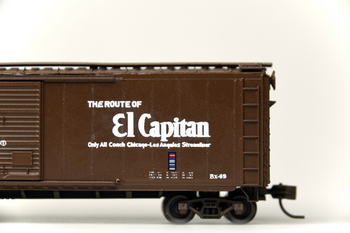 : ATSF 17298
: ATSF 172982016-11-18 09:00
コメント(0)
Paint Shop – 49 : Atchison, Topeka & Santa Fe Boxcar 17298, part 2 [Works_Boxcars]
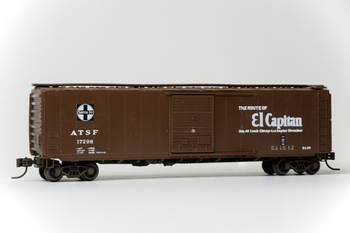 : L-side, ATSF 17298
: L-side, ATSF 17298Here are the data of the car and a belief history of the railroad.
ATSF 17000-17499 series Bx-69 class Boxcars
According to Morning Sun book ATSF Color Guide to Freight and Passenger Equipment, Bx-69 Class XM cars were built by American Car & Foundry in 1955. They were applied slogan stenciling introduced in 1947.
ATSF Car Slogan list suggests #17000 to #17199 in this series were applied Super Chief, #17200 to #17349 were applied El Capitan and #17350 to #17499 were applied Chief.
The ORER for July 1974 shows the group with 451 cars in place, described as follows:
AAR Designation XM, Box, Stl. Sheathed. The inside length of these cars is 50 feet 6 inches, inside width 9 feet 4 inches, inside height 10 feet 5 inches, outside length 54 feet 4 inches, extreme height 15 feet and capacity 4925 cubic feet or 100,000 pounds.
Train #17 and 18, El Capitan was the hi-level lightweight streamlined passenger train connecting Chicago and Los Angeles via La Junta, Colorado and Albuquerque, New Mexico. The train was inaugurated in 1938 and lasted until 1971.
Atchison, Topeka & Santa Fe Railway
See Paint Shop – 47 : Atchison, Topeka & Santa Fe Boxcar 42076, part 2
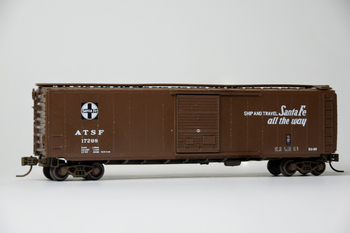 : R-side, ATSF 17298
: R-side, ATSF 172982016-11-25 09:00
コメント(2)
Paint Shop – 50 : Atchison, Topeka & Santa Fe Boxcar 12672, part 1 [Works_Boxcars]
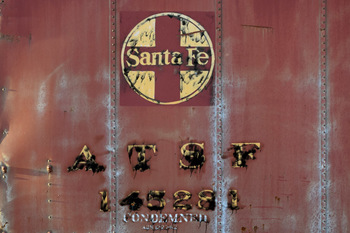 : Albuquerque, NM. Sep. 8, 2015
: Albuquerque, NM. Sep. 8, 2015I decided to add other 50’ slogan cars to my collection, complementing my San Francisco Chief and El Capitan cars.
The added is one of Bx-74 class XL boxcar with Texas Chief slogan. 1959 photo of #12672 is found at City of Vancouver Archives site. Railroad Picture Archives site has photos of #12605 and #12653 both with Texas Chief slogan.
I used stock MTL 031 series 50’ Standard Single Door Boxcar for the model. I changed the doors with Pullman doors copied from Atlas Master PS-1 40’ Boxcar. Side panel joints are corrected based on the prototype. I also cut the side sills referring to the prototype.
I painted the body with Tamiya TS-69, a little more brownish than Tamiya TS-33. Ends and roof were painted black. Before applying decals, I polished the surface of the painted body, where decals were going to be applied, with compound. Decal used is Microscale #60-506. Texas Chief slogan is applied on the right side based on the prototype photo. Semi-gloss clear coat is sprayed after decal is applied.
* 1959 photo of #12672 found at City of Vancouver Archives site;
* 1983 photo of #12605 found at Railroad Picture Archives site;
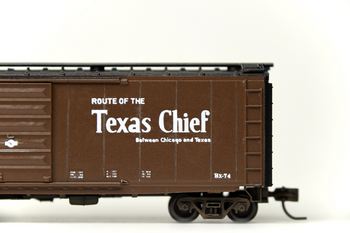 : ATSF 12672
: ATSF 126722016-12-02 09:00
コメント(3)
Paint Shop – 51 : Atchison, Topeka & Santa Fe Boxcar 12672, part 2 [Works_Boxcars]
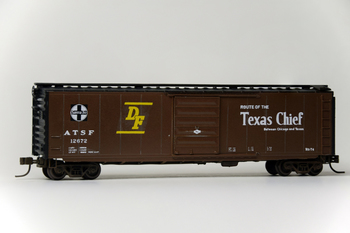 : R-side, ATSF 12672
: R-side, ATSF 12672Here are the data of the car and a belief history of the railroad.
ATSF 12500-12699 series Bx-74 class Boxcars
Bx-74 Class XL cars were built by Pullman-Standard in 1957. They were applied slogan stenciling introduced in 1947. ATSF Car Slogan list suggests #12500 to #12599 in this series were applied San Francisco Chief, while #12600 to #12699 were applied Texas Chief. This #12672 has Texas Chief slogan on the right side, contrary to the norm.
The ORER for July 1974 shows the group #12500 to #12899 with 372 cars in place, described as follows:
AAR Designation XL, Box, DF Loaders. The inside length of these cars is 50 feet 6 inches, inside width 9 feet 2 inches, inside height 10 feet 5 inches, outside length 56 feet 2 inches, extreme height 15 feet 1 inch and capacity 4838 cubic feet or 100,000 pounds.
Train #15 and 16, Texas Chief was the streamliner passenger service connecting Chicago and Galveston, Texas on Gulf of Mexico via Kansas City and Oklahoma City. The train was inaugurated in 1948 and lasted until 1971.
Atchison, Topeka & Santa Fe Railway
See Paint Shop – 47 : Atchison, Topeka & Santa Fe Boxcar 42076, part 2
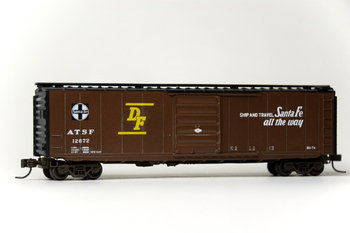 : L-side, ATSF 12672
: L-side, ATSF 126722016-12-09 09:00
コメント(0)
Paint Shop – 52 : Atchison, Topeka & Santa Fe Boxcar 12226, part 1 [Works_Boxcars]
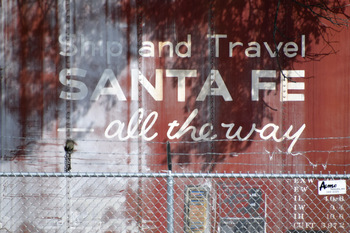 : Mountainair, NM. Sep. 9, 2015
: Mountainair, NM. Sep. 9, 2015I decided to add other ATSF 50’ slogan cars to my collection, complementing my San Francisco Chief, Texas Chief and El Capitan cars.
The added is a boxcar with Super Chief slogan. As I previously made Bx-74, 72 and 69 class boxcars, I went to other classes. After all, I decided to make a Bx-70 class boxcar as Railroad Picture Archives site had both side photos of Bx-70 class #12226 with Super Chief slogan, taken in 1979 and 1980.
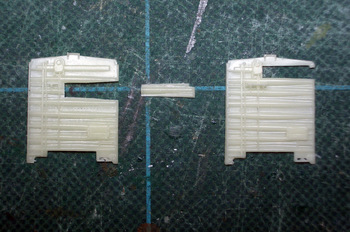 : modifying the end
: modifying the end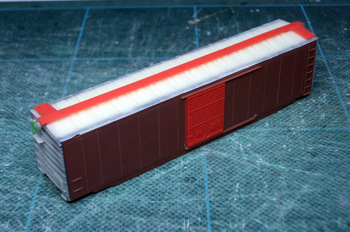 : body ready to paint
: body ready to paintI used stock MTL 077 series 50’ Standard Single Door Boxcar for the model. I replaced the ends with copied and modified MTL 51’ 3¾” Mechanical Reefer ends. Roof is replaced with diagonal panel roof copied from Athearn NACC boxcar. I also cut the side sills referring to the prototype. Rivets are Archer product. I replaced the assorted MTL roller bearing tracks with surplus Athearn Bettendorf tracks.
I painted the body with Tamiya TS-69, a little more brownish than Tamiya TS-33. Before applying decals, I polished the surface of the painted body, where decals were going to be applied, with compound. Decals used are Microscale #60-505 and #60-506. Super Chief slogan is applied on side to the right from the B-end based on Santa Fe Car Slogans list at Santa Fe Railway Historical & Modeling Society web site. As I ran out of “DF” decal, I applied clear decal for the further supplement. Semi-gloss clear coat is sprayed after decal is applied.
* 1979 R-side photo of #12226 found at Railroad Picture Archives site;
* 1980 L-side photo of #12226 found at Railroad Picture Archives site;
* Santa Fe Car Slogans list at Santa Fe Railway Historical & Modeling Society web site;
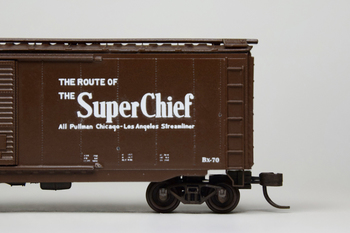 : ATSF 12226
: ATSF 122262017-01-27 09:00
コメント(2)
Paint Shop – 53 : Atchison, Topeka & Santa Fe Boxcar 12226, part 2 [Works_Boxcars]
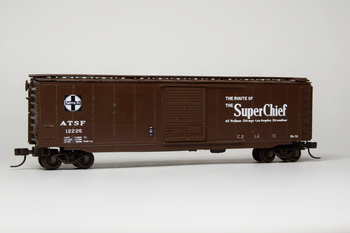 : R-side, ATSF 12226
: R-side, ATSF 12226Here are the data of the car and a belief history of the railroad.
ATSF 12200-12499 series Bx-70 class Boxcars
Bx-70 Class XL cars were built by American Car and Foundry in 1956. They were applied slogan stenciling introduced in 1947. ATSF Car Slogan list suggests #12200 to #12299 in this series were applied Super Chief, #12300 to #12399 were applied Grand Canyon and #12400 to #12499 were applied Chief. This #12226 has Super Chief slogan on the right side, contrary to the norm.
The ORER for July 1974 shows the group #12200 to #12498 with 276 cars in place, described as follows:
AAR Designation XL, Box, DF Loaders, Nailable Stl. Flrs. The inside length of these cars is 50 feet 6 inches, inside width 9 feet 2 inches, inside height 10 feet 6 inches, outside length 54 feet 4 inches, extreme height 15 feet 1 inch and capacity 4868 cubic feet or 100,000 pounds.
Train #17 and 18, The Super Chief was the passenger service connecting Chicago and Los Angeles via La Junta. The train was inaugurated in 1936 with all-Pullman heavyweight consist. It was reequipped with lightweight streamliner in 1937, and lasted until 1971.
Atchison, Topeka & Santa Fe Railway
See Paint Shop – 47 : Atchison, Topeka & Santa Fe Boxcar 42076, part 2
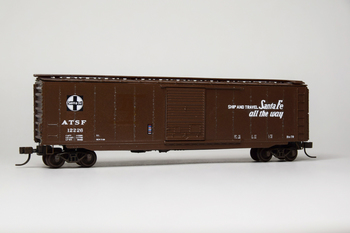 : L-side, ATSF 12226
: L-side, ATSF 122262017-02-03 09:00
コメント(0)
Paint Shop – 54 : Atchison, Topeka & Santa Fe Boxcar 16605, part 1 [Works_Boxcars]
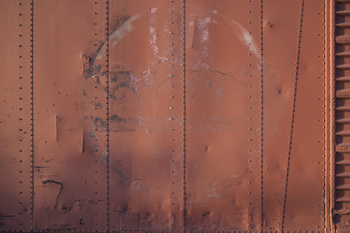 : Los Lunas, NM. Sep. 9, 2015
: Los Lunas, NM. Sep. 9, 2015I decided to add other 50’ slogan cars to my collection, complementing my San Francisco Chief, Texas Chief and El Capitan cars.
This time, the added is a boxcar with the Chief slogan. Searching ATSF 50’ boxcar classes other than I previously made brought the Bx-66 class. Railroad Picture Archives site had a 1978 photo of Bx-66 class #16605 with the Chief slogan. Accordingly, I decided to make this car.
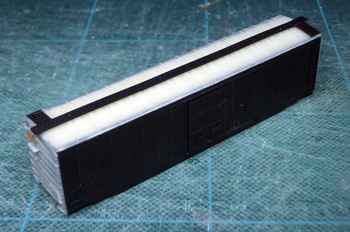 : body ready to paint
: body ready to paintI used stock MTL 031 series 50’ Standard Single Door Boxcar for the model. I replaced the ends with copied and modified MTL 51’ 3¾” Mechanical Reefer ends. Roof is replaced with diagonal panel roof copied from Athearn NACC boxcar. I also cut the side sills referring to the prototype. Side panel joints are corrected based on the prototype. Rivets are of Archer product. I replaced the assorted MTL roller bearing tracks with surplus Athearn Bettendorf tracks.
I painted the body with Tamiya TS-69, a little more brownish than Tamiya TS-33. Before applying decals, I polished the surface of the painted body, where decals were going to be applied, with compound. Decal used is Microscale #60-505. Chief slogan is applied on side to the left from the B-end according to the prototype photo. Semi-gloss clear coat is sprayed after decal is applied.
* 1978 photo of #16605 found at Railroad Picture Archives site;
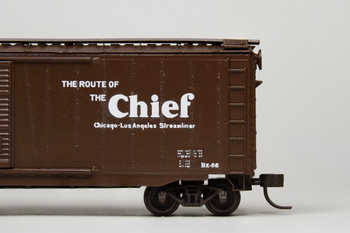 : ATSF 16605
: ATSF 166052017-02-10 09:00
コメント(0)
Paint Shop – 55 : Atchison, Topeka & Santa Fe Boxcar 16605, part 2 [Works_Boxcars]
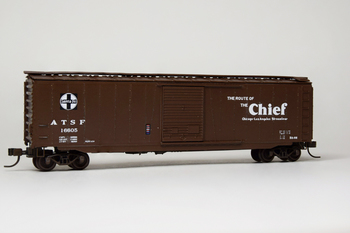 : L-side, ATSF 16605
: L-side, ATSF 16605Here are the data of the car and a belief history of the railroad.
ATSF 11300-11399 and 16250-16649 series Bx-66 class Boxcars
Five hundred Bx-66 Class XM/L cars were built by ATSF in 1954. They were applied slogan stenciling introduced in 1947. ATSF Car Slogan list suggests #11300 to #11399 in this series were applied Grand canyon, #16250 to #16349 were applied El Capitan, #16350 to #16499 were applied Super Chief and #16500 to #16649 were applied Chief. This #16605 has the Chief slogan on the left side, ordinary to the norm.
The ORER for July 1974 shows the class in three groups:
The group #11300 to #11395 with 38 cars in place, described as follows:
AAR Designation XL, Box, DF Loaders. The inside length of these cars is 50 feet 6 inches, inside width 9 feet 2 inches, inside height 10 feet 6 inches, outside length 54 feet 5 inches, extreme height 15 feet 1 inch and capacity 4873 cubic feet or 100,000 pounds.
The group #16250 to #16639 with 357 cars in place, described as follows:
AAR Designation XM, Box, Stl. Sheathed. The inside length of these cars is 50 feet 6 inches, inside width 9 feet 4 inches, inside height 10 feet 6 inches, outside length 54 feet 6 inches, extreme height 15 feet 1 inch and capacity 4955 cubic feet or 100,000 pounds.
The group #16641 to #16649 with 7 cars in place, described as follows:
AAR Designation XM, Box, Stl. Sheathed, Nailable Stl. Flr. The inside length of these cars is 50 feet 6 inches, inside width 9 feet 4 inches, inside height 10 feet 6 inches, outside length 54 feet 6 inches, extreme height 15 feet 1 inch and capacity 4955 cubic feet or 100,000 pounds.
Train #19 and 20, the Chief was the passenger service connecting Chicago and Los Angeles via La Junta. The train was inaugurated in 1926 with all-Pullman heavyweight consist. It was reequipped with lightweight streamliner in 1938, and lasted until 1968.
Atchison, Topeka & Santa Fe Railway
See Paint Shop – 47 : Atchison, Topeka & Santa Fe Boxcar 42076, part 2
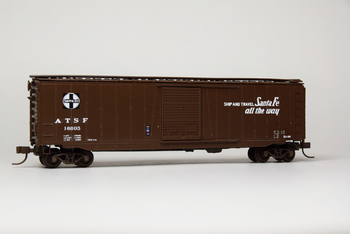 : R-side, ATSF 16605
: R-side, ATSF 166052017-02-17 09:00
コメント(0)
Paint Shop – 56 : Central Of Georgia Boxcar 2132, part 1 [Works_Boxcars]
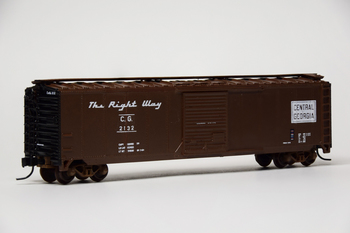 : CG2132
: CG2132Micro-Trains produced the exact car in January 2014 in “Weathered” version. But, according to the prototype photo found at RR Picture Archives.NET, the MTL 031 series body they used is far from accurate. Accordingly, I tried to make my own.
I used surplus Atlas Trainman 50’ Double door Box Car as it had accurate ends: single door car would have been better. I scraped off the molded doors and applied 9’ Youngstown Door copied from Athearn PS-1 Single Door Box Car. Diagonal panels are adopted as the center portion of the roof. I also modified the sill. Added rivets are Archer product.
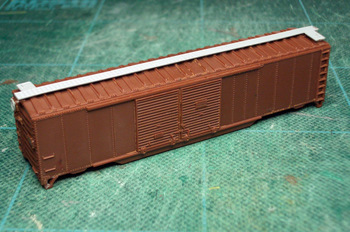 : naked Atlas body
: naked Atlas body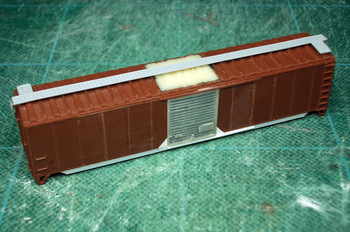 : body ready to paint
: body ready to paintI spray painted the body with Tamiya spray paint TS-69 Linoleum Deck Brown. Ends are painted black. Before applying the decals, I polished the surface of the painted body, where they were going to be applied, with the compound. Decal used is Microscale #60-1079. The semi-gloss clear coat is sprayed after decal is dried.
* 1974 photo of CG 2132 found at RR Picture Archives.NET;
* decal I used;
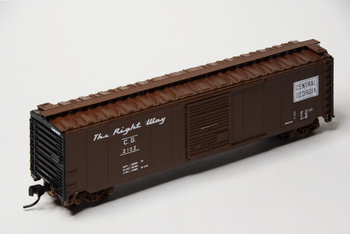 : CG2132
: CG21322017-05-05 09:00
コメント(0)
Paint Shop – 57 : Central Of Georgia Boxcar 2132, part 2 [Works_Boxcars]
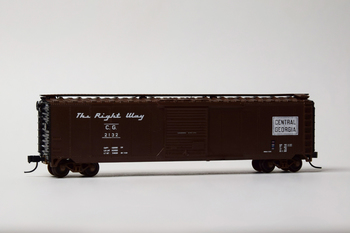 : CG2132
: CG2132Here are the data of the car and a belief history of the railroad.
CG 2000-2369 series Boxcars:
According to Classic Freight Cars Vol.8: 50Ft. Boxcars, CG 2000-2369 series boxcars were built in 1964 as XML with partial DF loaders. But concerning the classic rounded corner Dreadnaught Ends they have, original built-date may date back to at least before 1945 when Improved Dreadnaught ends were introduced.
In 1965 and 1966, CG picked some CG 6300-6999 series 40’ boxcars to rebuild CG 2441-2998, later SOU 521500-522057 series 50’ boxcars, according to SOU Morning Sun Color Guide. Therefore, I came to believe CG 2000-2369 series cars were rebuilt in 1964, the given built-date by Classic Freight Cars.
Indeed, the CG Equipment Diagram revised in May 1964 certifies that 2000-2369 series boxcars were rebuilt from 4500-4749, 6000-6099, 6100-6149 and 6500-6599 series 40’ boxcars by Greenville Steel Car Company[1].
But all the 4500-4749 series cars built by Pullman-Standard in 1945[2], 6000-6099 series cars built by Pullman-Standard in 1941[3], 6100-6149 series cars built by Pullman-Standard in 1942[4] and 6500-6599 series cars built by Pullman-Standard in 1941[5] had Murphy Dreadnaught Ends. Accordingly, we cannot suggest the original number or series of CG 2132 based on its ends.
The ORER for July 1974 shows the group #2000 to #2369 with 108 cars in place, described as follows:
AAR Designation XM, Box. The inside length of these cars is 50 feet 6 inches, inside width 9 feet 2 inches, inside height 10 feet, outside length 54 feet 4 inches, extreme height 15 feet and capacity 4626 cubic feet or 110,000 pounds.
Besides, nine XL cars 2010, 2058, 2073, 2107, 2125, 2193, 2289, 2316 and 2326, described as Box, DF Belt Rails, are listed separately.
[1] CG 2000-2369 series boxcar diagram at N&W Historical Society web page;
[2] CG 4500-4749 series boxcar diagram at N&W Historical Society web page;
[3] CG 6000-6099 series boxcar diagram at N&W Historical Society web page;
[4] CG 6100-6149 series boxcar diagram at N&W Historical Society web page;
[5] CG 6500-6599 series boxcar diagram at N&W Historical Society web page;
Central of Georgia Railway (reporting mark CG) mainly served Savannah, Macon and other parts of Georgia.
The origin of the railway was the Central Rail Road and Canal Company, later Central Rail Road and Banking Company, established in 1833. The railroad grew through absorbing neighboring railroads. Unfortunately, however, it went bankrupt in 1888 and being reorganized as the Central of Georgia Railway in 1895.
Southern Railway took control of the railway in 1963. In 1971, CG, Savannah and Atlanta Railway and others merged to form Central of Georgia Railroad, which still exists today as an affiliate in the books of Norfolk Southern Railway[6].
The map below is the part of Union Pacific Map of the United States printed in 1971, with the CG route traced by the author.
[6] Norfolk Southern Railway Company –Terms of Conditions-;
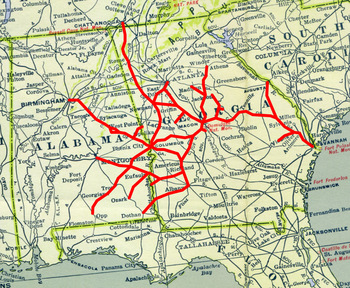 : CG route map
: CG route map2017-05-12 09:00
コメント(0)
Paint Shop – 58 : Minneapolis & St Louis Boxcar 2048, part 1 [Works_Boxcars]
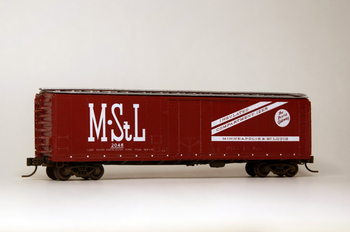 : MSTL 2048
: MSTL 2048Minneapolis & St Louis boxcars are familiar to us by its impressive scheme. Thanks to the scheme, we have a lot of HO scale models but left the N scale models. Accordingly, I decided to make my own using N scale decals introduced in Aug. 2015 by Microscale.
Compared to the model photos, prototype photos are relatively few. I could find only one photo on web: MSTL 2038 at RR Photo Archives site. I found another in the book The Model Railroader’s Guide to Freight Cars: MSTL 2048. As this photo was more large and clear, I decided to make #2048.
I used surplus MTL #038 series 50’ Standard Boxcar w/Plug door for the model. I scraped off the molded panel joints on sides and replaced them with Archer rivets. I replaced the ends with copied and modified MTL 51’ 3¾” Mechanical Reefer ends. The roof is also replaced with diagonal panel roof copied from Athearn NACC boxcar. Sills are cut, partly added. Roof walk is an MTL product.
I spray painted the body with Mr. Color spray paint #81 Russet. The roof is painted silver. Before applying the decals, I polished the surface of the painted body, where decals were going to be applied, with the compound. Decal used is Microscale #60-1509. The semi-gloss clear coat is sprayed after decal is dried.
* photo of MSTL 2038 found at RR Picture Archives.NET;
* decal I used;
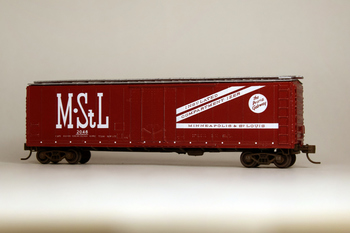 : MSTL 2048
: MSTL 20482017-06-16 09:00
コメント(0)
Paint Shop – 59 : Minneapolis & St Louis Boxcar 2048, part 2 [Works_Boxcars]
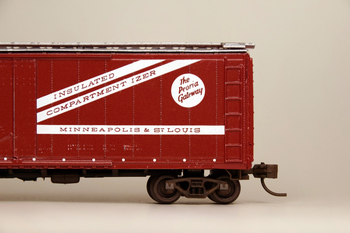 : MSTL 2048
: MSTL 2048Here are the data of the car and a belief history of the railroad.
MSTL 2000 series Boxcars:
Plug doors on freight equipment came in to use in the early ’50s. MSTL 2000 series cars were built in 1957: one of the early examples of insulated boxcars. In 1956, by then president Albert W. Schroeder had introduced the striking fire engine red and off-white scheme[1]. They were repainted to C&NW scheme after the acquisition[2].
The ORER for July 1974 shows the group #2000 to #2058 with 28 cars in place, described as follows:
AAR Designation RBL, Refrig., Compartmentizers, Even Nos. The inside length of these cars is 50 feet, inside width 9 feet 2 inches, inside height 9 feet 1 inch, outside length 54 feet 9 inches, extreme height 14 feet 1 inch and capacity 4163 cubic feet or 132,000 pounds.
Minneapolis & St Louis Railway (reporting mark MSTL) established in 1870, was the railroad extended south and west from Minneapolis, Minnesota. Unfortunately, however, the traffic was relatively light, therewith the railroad was in receivership between 1923 and 1943. Conclusively, the railroad was acquired by Chicago & North Western Railway in 1960. Most of the route is abandoned today.
Founder of Sears, Roebuck and Company, Richard Warren Sears(1863 – 1914) was the agent at North Redwood, MN in the 1880s[3].
The map below is the part of Union Pacific Map of the United States printed in 1971, with the MSTL route traced in green line by the author.
[1] Piersen, Joe., (2004) Minneapolis & St. Louis Railroad – A Capsule History, Chicago & North Western Historical Society;
[2] 1977 photo of MSTL 2016 in C&NW scheme;
[3] Sears History - 1886, Sears Archives;
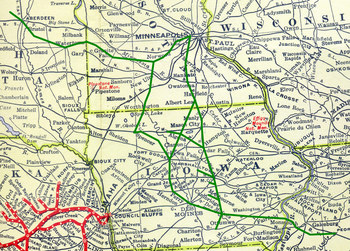 : MSTL route
: MSTL route2017-06-23 09:00
コメント(0)
Paint Shop – 60 : Minneapolis & St Louis Boxcar 2520, part 1 [Works_Boxcars]
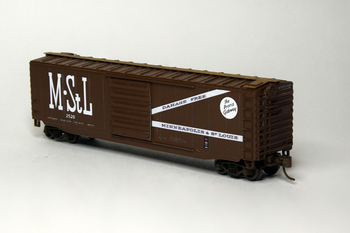 : MSTL 2520
: MSTL 2520Here is another Minneapolis & St Louis boxcar with the impressive scheme introduced in 1956. The scheme varies according to its types of equipment: cars with compartmentizers have “COMPARTMENTIZER” slogans, insulated cars have “INSULATED” slogans and cars with DF loaders have “DAMAGE FREE” slogans. I previously represented “INSULATED”, “COMPARTMENTIZER” car. So, this time, I represent a “DAMAGE FREE” car.
The only prototype photo of “DAMAGE FREE” car I found was of MSTL “2526” by Jonathan Spurlock at RR Photo Archives site: I once saw a prototype photo, not the Kadee HO model photo, of MSTL 2516 but cannot recall where I saw that.
But, according to the builder’s list, MSTL 2526 never existed: 2500/2502, 2504 – 2520 and 2800 are the only 50’ PS-1’s Pullman built for MSTL. Retouching the Spurlock’s photo brought to me that it can be read as 2520. Accordingly, I decided to make MSTL 2520.
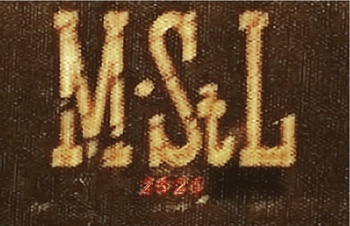 : retouched photo of MSTL “2526”
: retouched photo of MSTL “2526”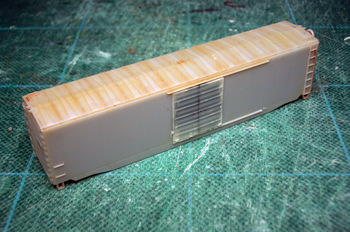 : body ready to paint
: body ready to paintI used surplus Athearn 50’ PS-1 Single Door Boxcar for the model. I scraped off the molded doors and replaced with copied and modified Atlas Pullman doors: single 9’ door from two 8’ doors.
I spray painted the body with Tamiya spray paint TS-69 Linoleum Deck Brown. Before applying the decals, I polished the surface of the painted body, where decals were going to be applied, with the compound. Decal used is Microscale #60-1509 except for homemade “DAMAGE FREE” slogan. The semi-gloss clear coat is sprayed after decal is dried.
* 1978 prototype photo of MSTL “2526” by Jonathan Spurlock;
* another photo of MSTL “2526” by Jonathan Spurlock;
2017-08-25 09:00
コメント(0)



